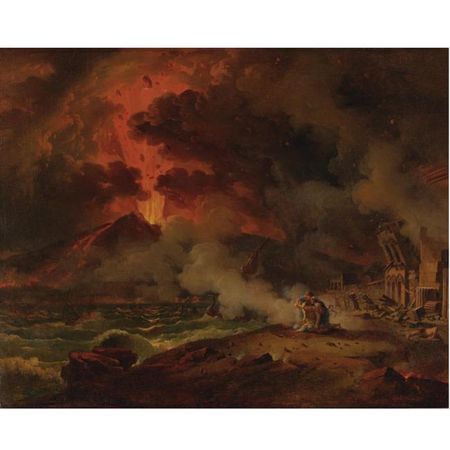Pierre-Henri de Valenciennes (Toulouse 1750 - 1819 Paris), The Destruction of Pompeii
Pierre-Henri de Valenciennes (Toulouse 1750 - 1819 Paris), The Destruction of Pompeii
oil on canvas. 25 3/4 by 31 7/8 in.; 66.5 by 80.8 cm. Estimate 150,000—200,000 USD
LITERATURE AND REFERENCES: Probably Toulouse et le Néoclassicisme Les Artistes Toulousains de 1775 à 1830, exhibition catalogue, Toulouse 1989, p. 118, under cat. no. 133.
NOTE: Valenciennes was born in Toulouse and received his formal training there at the Academy prior to joining the studio of Jean-Baptiste Despax as an apprentice. In 1769 he made his first trip to Rome where he met a number of foreign artists, not least of whom was Hubert Robert, who presumably first inspired Valenciennes' affinity for landscape painting. In 1777 he made a second trip to Rome where he met Claude-Joseph Vernet, who inspired him to embrace landscape painting, and more specifically the practice of oil sketches. This led him to become one of the leading plein-air practitioners. He encouraged his pupils to embrace the act of painting in nature at all times of year in order to depict landscapes as realistically as possible. Among his eventual pupils were Achille Michallon, Pierre-Athanase Chauvin and Jean-Victor Bertin, through whose work Valenciennes' influence is clear in the styles of Corot and the Barbizon group.
This painting displays the artist's affinity for accurate depictions of nature, coupled with the classical iconography taught almost universally throughout the French académies. Compositions depicting Vesuvius became increasingly popular among European artists in the latter decades of the 18th century as after a long period of dormancy, the volcano began to erupt with some frequency, providing a dramatic setting for both foreign and local artists. Valenciennes painted this picture around 1814, but accumulated his research material and preliminary sketches during his second trip to Rome. This particular image is not a depiction of a contemporary eruption, but rather a recreation of the legendary 79 A.D. event which destroyed the ancient cities of Pompeii and Herculaneum.
It is a reduced version of a painting that Valenciennes exhibited at the Salon in 1814, which today hangs in the National Gallery, Washington D.C. The drama here is undeniable. The smoke which hovers over the landscape can be followed from the lower right hand side of the canvas, all the way to the summit of the volcano and the explosion of lava. This compositional choice carries the viewer's eye towards the eruption, further heightening the drama of the scene. In the foreground, Valenciennes has depicted the death of Pliny the Elder who, having approached too close in order to observe the phenomenon, was overcome by the poisonous gases emitted by the volcano.
Sotheby's. Important Old Master Paintings, Including European Works of Art. 29 Jan 09. New York www.sothebys.com photo courtesy Sotheby's

/https%3A%2F%2Fprofilepics.canalblog.com%2Fprofilepics%2F1%2F0%2F100183.jpg)
/https%3A%2F%2Fstorage.canalblog.com%2F03%2F02%2F119589%2F96711876_o.jpg)
/https%3A%2F%2Fstorage.canalblog.com%2F11%2F31%2F119589%2F94773502_o.jpg)
/https%3A%2F%2Fstorage.canalblog.com%2F20%2F83%2F119589%2F94772815_o.jpg)
/https%3A%2F%2Fstorage.canalblog.com%2F26%2F72%2F119589%2F75604929_o.jpg)
/https%3A%2F%2Fstorage.canalblog.com%2F59%2F60%2F119589%2F26458628_o.jpg)



/http%3A%2F%2Fstorage.canalblog.com%2F31%2F18%2F119589%2F120437734_o.jpg)
/http%3A%2F%2Fstorage.canalblog.com%2F24%2F74%2F119589%2F120437074_o.jpg)
/http%3A%2F%2Fstorage.canalblog.com%2F29%2F81%2F119589%2F120373953_o.jpg)
/http%3A%2F%2Fstorage.canalblog.com%2F39%2F08%2F119589%2F112364211_o.jpg)